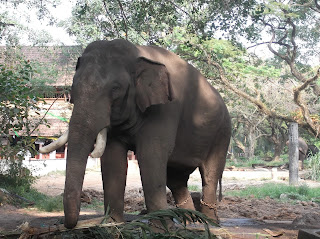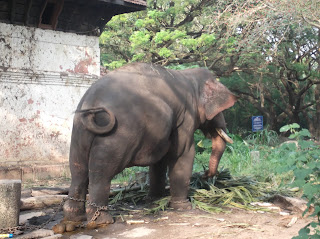Gajarajan Kesavan
The Guruvayur Devaswom maintains a unique elephant sanctuary,
the only one of its kind in the World. It has 51 elephants now. These jumbos
are the offerings of the devotees to the Lord. A large number of pilgrims and
tourists visit this fascinating spot every day. In this vast compound, there
are road facilities for pilgrims and tourists to go around.
The present elephant sanctuary is in Punnathur Kotta
about 3 kms north of Guruvayur temple. Punnathur Kotta is the ancient palace of the
Punnathur Rajas, now in the possession of the Devaswom. There is also an
ancient temple where Lord Siva and Bhagavathy are worshipped.
It is a 10 acre compound which Devaswom purchased in
1975, which was under receiver rule of Trichur sub court. Till that time
elephants were kept in this Kovilakam compound (present Sreevalsam) to the
south of the temple.
All the elephants were shifted to the Punnathur Kotta
in a grant procession lead by Gajarajan Kesavan, all the elephants from the Kovilakam marched to Punnathur Kotta
on 1975 June 25.
Many elephants of Guruvayur have become the part of
history. The sweet memories of Gajarajan
Kesavan - literally the king
of all Elephants- still enthrall the hearts of the elephant lovers worldwide.
The mammoth physique, his intelligence and devotion to the Lord were very
famous.
Punnathurkotta was once the palace of a local ruler,
but the palace grounds are now used to house the elephants belonging to the
Guruvayoor temple, and has been renamed Anakkotta (meaning "Elephant Fort").
There were 86 elephants housed there, but currently there are about 66
elephants. The elephants are ritual offerings made by the devotees of Lord
Guruvayurappa. This facility is also used to train the elephants to serve Lord
Krishna as well as participate in many festivals that occur throughout the
year. The oldest elephant is around 82 years of age and is called
'Ramachandran'. The rituals ofGajapooja (Worshipping Elephants) and Anayoottu
(Feeding Elephants) are observed here, as an offering to Lord Ganesha. The
legendary elephant "Guruvayur Keshavan" was housed here. The compound
also has a naalu kettu, a traditional rectangular home with a central
courtyard, which belonged to the Punnathur Raja. It is poorly maintained and
presently houses a training school for Papans
(Mahout). This complex also contains a temple dedicated to Lord Shiva and
Bhagavathy.
The visiting hours are 8.00AM to 6.00PM. The entry
fees are Rs. 10/- per adult & Rs. 5/- for Children. An extra Rs. 25/- is
charged for to use a camera and Rs. 1000/- inside the complex.
 guruvayoor padmanabhan
guruvayoor padmanabhan
NAME OF ELEPHANT
|
Padmanabhan
|
Ramankutty
|
Narayanankutty
|
Thara
|
Radhakrishnan
|
Junior Lakshmanan
|
Nandini
|
Gopalakrishnan
|
Kannan
|
Krishnan
|
Madhavankutty
|
Devi
|
Sathyanarayanan
|
Vishnu
|
Rajasekharan
|
Ramu
|
Kesavankutty
|
Gopeekrishnan
|
Vinayakan
|
Kesavan
|
Achuthan
|
Sreedharan
|
Chandrasekharan
|
Indersen
|
Nandan
|
Lakshmikrishna
|
Sankaranarayanan
|
Balu
|
Madhavan(junior)
|
Devadas
|
Gopeekannan
|
Resmi
|
Balakrishnan
|
Junior Vishnu
|
Murali
|
Vineethkrishnan
|
Ravikrishnan
|
Sidharthan
|
Mukundan
|
Navaneethkrishnan
|
Junior Kesavan
|
Balaram
|
Krishna
|
Junior Achuthan
|
Chenthamarakshan
|
Akshaykrishnan
|
Krishnanarayanan
|
Gokul
|
Sheshadri
|
Gajendra
|
Peethambaran
|
Damodardas
|
Keerthi
|
Aadhithyan
|
Lakshminarayanan
|
Sreekrishnan
|
Ananthanarayanan
|
Ayyappankutty
|


















































